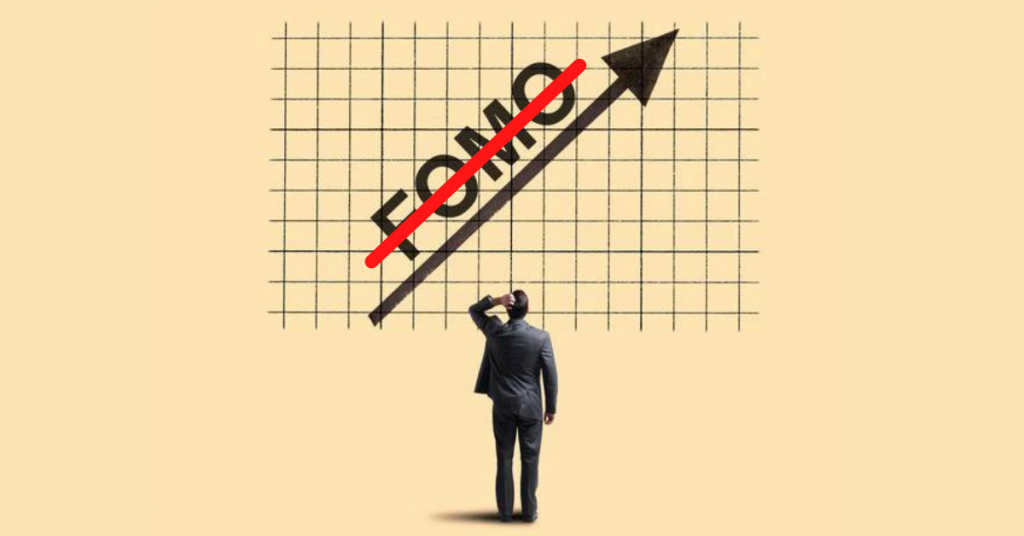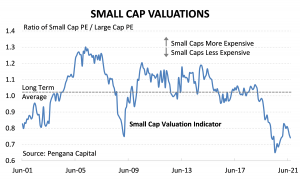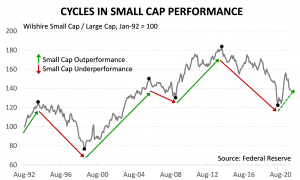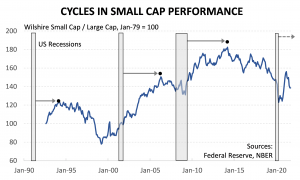Smaller Companies: FOMO Not Required

Author: Steven Milch, Consulting economist
Print PDF Version
Small Cap Fomo
‘Fear of missing out’ – one of the defining phrases of our generation and a concept that certainly applies to investment psychology.
Amongst the challenges of successful investing is not just identifying profitable opportunities but knowing when to invest. One might identify an opportunity only to be ‘late to the party’. Other themes are more enduring and allow ample time to capture the gains. For example, the great bond rally which saw yields decline from 17% in 1982 to 1% in 2020 lasted 38 years!
The first article in this series, The New Economic Cycle, explored today’s ‘reflationary’ economic cycle and associated investment themes, including the rally in small-cap stocks. Below, we explore how long we can expect this theme to last, with the conclusion that the cycle may only just be getting underway.
Policy underwrites the expansion
The New Economic Cycle noted not only that “the greater breadth of economic activity, across and within economies, will allow smaller businesses to benefit” but also that it’s been over a decade since we’ve experienced such a ‘reflation’ cycle.
The cycle is also being driven by powerful forces, including a philosophical shift on the part of policymakers. In the US, for example, the fiscal response to COVID-19 amounted to a whopping 25% of GDP as at June 2021[1] and is expected to rise further with the Infrastructure Investment and Jobs Act which is being viewed as a “generational investment” [2] for the US economy.
In Europe, the European Central Bank has adopted a more inflation-tolerant and growth-supportive stance by announcing a subtle but important change to its inflation target (from “below, but close to, 2%” to “2% over the medium term” [3]) and a commitment to meet the target through “persistently accommodative monetary policy” [4].
These policy shifts are likely to play out over years, providing enduring support for the ‘stronger and broader’ growth theme and for small companies in sectors and regions that have lagged over recent years (including quality smaller companies in Europe and those geared towards consumer demand and business investment).
Value in small caps
Our previous article observed that “value is likely to lie in previously ‘unloved’ places” and that, in an environment of abundant growth, well-priced ‘value’ assets will benefit from scarcity. As our first chart shows, after underperforming for much of the past decade, ‘value’ certainly describes the small-cap sector.

The chart shows the highly attractive valuations of US and European small versus large-cap stocks (in a single indicator), with small-cap valuations currently trading 28% below the long-term average[5].
History provides a guide
Providing additional context, our second chart shows three cycles in the performance of US small versus large-cap stocks over the past 30 years[6], including the following episodes of small-cap outperformance:
- Up to Feb-94 (3 years, 9 months): the 1990-91 recession and Gulf War saw smaller companies commence a cycle of outperformance that began in Nov-90 and provided excess returns of 50%[7].
- Mar-99 – Apr-06 (7 years, 1 month): an extended upswing, incorporating the US ‘tech wreck’ recession of 2001 and subsequent credit-fuelled growth, saw small-cap stocks outperform large-cap names by 94%.
- Apr-08 – Mar-14 (5 years, 11 months): the Global Financial Crisis and widespread implementation of Quantitative Easing saw smaller company returns exceed those of large caps by 28% during this cycle.

The average duration of these four upswings is 5½ years, with small-cap stocks outperforming by an average of 57%. Assuming a similar cycle length from the August 2020 low in the small-cap performance ratio, suggests an upswing potentially extending into 2026.
Recession as a prelude to recovery
Another perspective is provided by our final chart, which shows that a recession featured relatively early in each of the three periods of small-cap outperformance. This relates to the profit recovery and improved risk appetite – both of which favour the performance of small-cap stocks – which typically follow recession (but may be anticipated by the market prior to the conclusion of the recession).
Taking the 1991, 2001, and 2008 recessions as a guide, peak small-cap performance was achieved, on average, 4 years following the recession. On this basis, it’s not unreasonable to expect the current small-cap cycle to extend well into 2024.

To conclude, the valuation and economic setup is in place for a cycle of small-cap outperformance. While investing has always been, and will always be inherently uncertain, history suggests we’re only in the early stages of the upswing and that Fear Of Missing Out is not required.
[1] IMF Fiscal Monitor Database of Country Fiscal Measures in Response to the COVID-19 Pandemic
[2] The Senate infrastructure bill puts America closer to another New Deal, 5th August 2021, The Brookings Institution
[3] Luis de Guindos, ECB Vice-President, interview with Miquel Roig and Jorge Zuloaga, 26th August 2021
[4] ECB Press release, 22nd July 2021
[5] The Small Cap Valuation Indicator is comprised of US small cap relative PE valuations (S&P600 versus S&P500) and European small cap relative PE valuations (Euro Stoxx Small Index versus Euro Stoxx 50 index) in 50:50 proportions
[6] Chart series includes the Wilshire US Small-Cap price index of stocks ranked 750 to 2,500 in size and the Wilshire US Large-Cap price index of stocks ranked above 750th in terms of size
[7] Norland, E., Trends in Small-Cap Stocks Amid Inflation, Turbulence, CME Group, 14th January 2021

